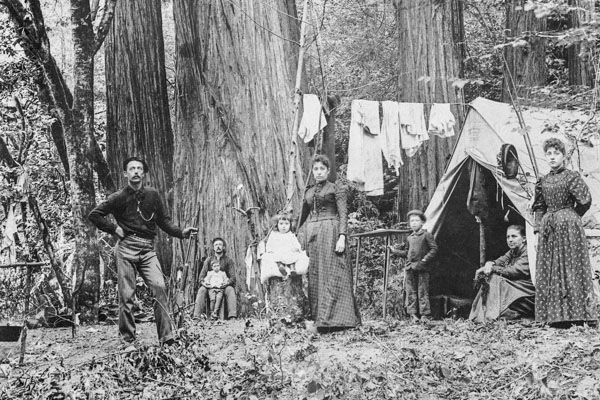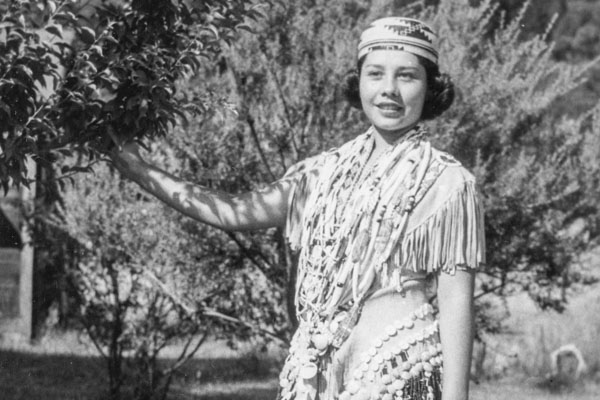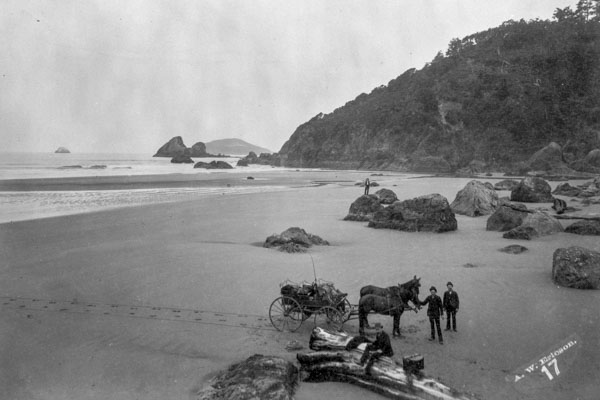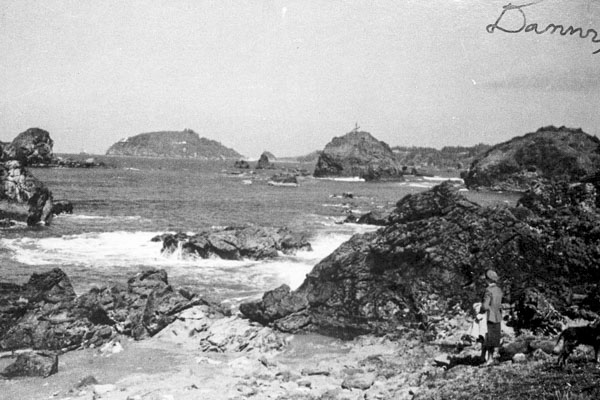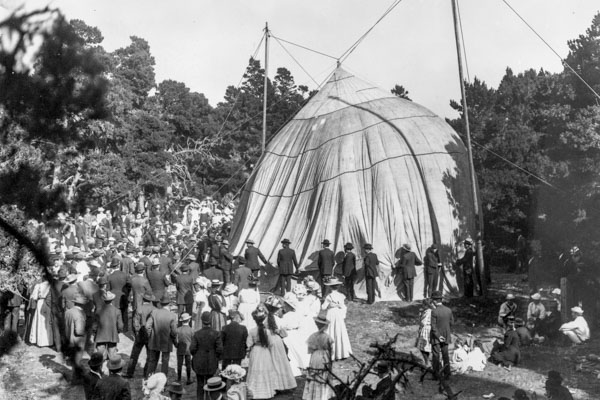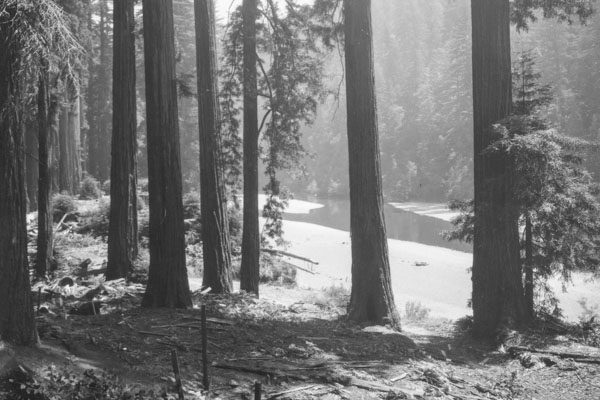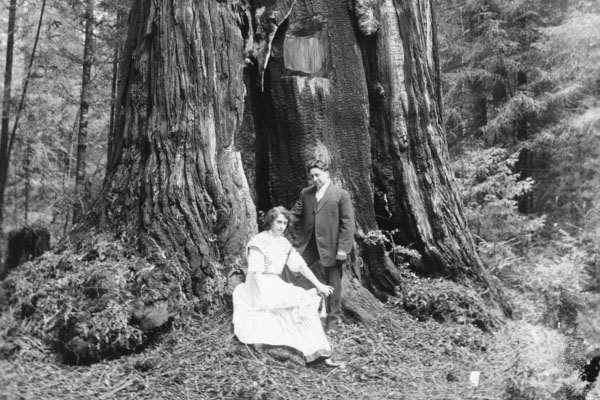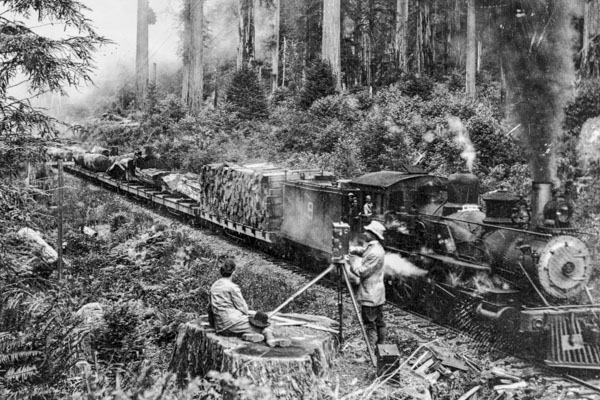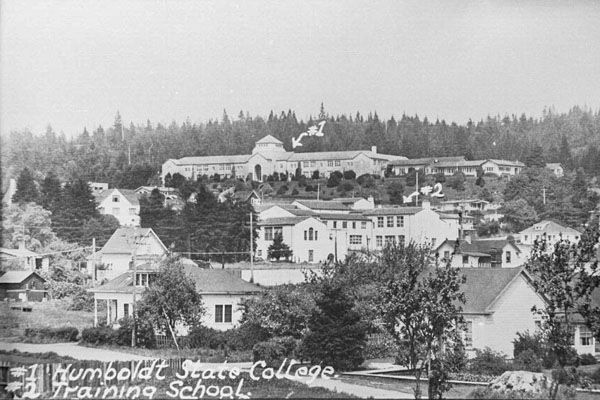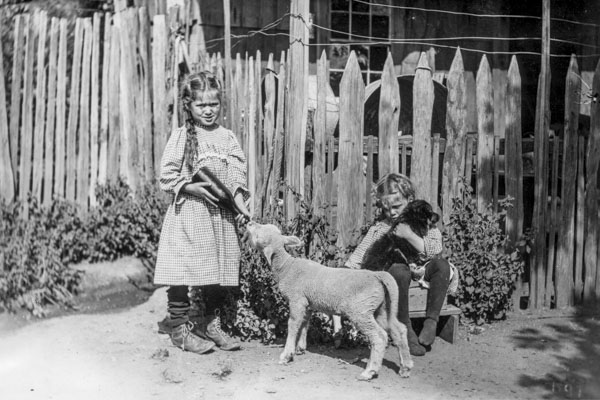You are here
Peter E. Palmquist Working Photograph Collection - Finding Aid
Abstract
Acquisition Information
Biographical Information
Scope and Content
Arrangement of Collection
Container List
Related Materials
Collection Number
2003.01
Contact Information
The University Library, Special Collections
Cal Poly Humboldt
One Harpst Street
Arcata, California 95521
Processed By
Edith Butler MA,CA, Stefani Baldivia, Katie LaSala
Date Collection Processed
2007-2011
Language
English
Collection Creator
Peter Palmquist, 1936-2003
Dates Covered by Collection
1860s–1970s; Bulk dates 1870s-1920s
Size of Collection
Approximately 5,000 images
Abstract
The Peter E. Palmquist Working Photograph Collection contains approximately 5,000 images from Northwest California, especially Humboldt County. 3,700 of these images can be viewed in the Library's Special Collections and searched through the Special Collections Photograph Collections database. There is a close association between this collection and major portions of the Peter E. Palmquist Photograph Collection at the Beinecke Rare Book and Manuscript Library at Yale University.
Access
The collection is open for research.
Copyright
Copyright was not transferred to the Cal Poly Humboldt Library.
Acquisition Information
In the mid 1990s the Beinecke Rare Book and Manuscript Library at Yale University made arrangements to purchase Palmquist's vast collection. As planned, different segments of the collection were transferred from Palmquist's Arcata home to the Beinecke starting in 1999. After Peter's sudden death in January 2003, the schedule for transferring the remainder of the collection changed and all remaining materials were transferred in 2003. As this transfer process was ending the Humboldt archivist consulted with George Miles, Curator of the Beinecke's Western Americana Collection, about the negatives and study prints that Palmquist had intended to keep for his own use. Mr. Miles stated that they were not going to be included in what would be transferred to the Beinecke. Later in 2003, the Palmquist heirs and executors donated them to the Cal Poly Humboldt Library Special Collections.
Biographical Information
Peter Palmquist spent his early years in Oakland, California, then moved to Humboldt County. The family lived outside Ferndale where Peter attended a one room elementary school. Starting at age 12 he taught himself photography. He graduated from Ferndale High School and then enlisted in the United State Army. While he was stationed in Paris with the Supreme Headquarters Allied Powers Europe, he continued his study of photography and began his professional work as photographer. When he returned to Humboldt County, bringing his young family, he attended Humboldt State College and was employed as the official university photographer. He held that position long after his 1965 graduation, finally retiring in 1989. Throughout those years Peter also ran a commercial photography business. Starting in 1971, Palmquist became interested in historical images, an interest that led him in many directions. He died in 2003 immediately after being gravely injured by a hit and run driver.
At first his interest in old photographs led to studying the history of his own profession and then the lives of past photographers, but it quickly incorporated an interest in the informational content revealed in a photograph. He started collecting images taken in northwestern California, but this soon broadened out to include other areas and led to a collection of images from all of western North America. Later his interest in women who worked in any aspect of photography led to extensive research in and collecting of photographs by women worldwide. Working with the Women in Photography International Peter developed and served as curator of the Women in Photography International Archive, which was housed at his home in Arcata. Throughout this time Peter generously shared the information he was discovering and collecting through numerous writings, exhibits, presentations, and workshops.
Additional information on Peter Palmquist, his life, activities, his own description of his collection and how he created it is available in these three documents:
- “
 California Photographers: A Personal Account Of Regionalism In Practice” by Peter Palmquist and included in Photographers: A Sourcebook for Historical Research; published by Carl Mautz; 1991. Included here with Mr. Mautz’ permission.
California Photographers: A Personal Account Of Regionalism In Practice” by Peter Palmquist and included in Photographers: A Sourcebook for Historical Research; published by Carl Mautz; 1991. Included here with Mr. Mautz’ permission.  Peter E. Palmquist 1936-2003 Booklet distributed at the April 12, 2003 memorial for Peter. Booklet compiled by Pam Mendelsohn. Included here with Ms. Mendelsohn’s permission.
Peter E. Palmquist 1936-2003 Booklet distributed at the April 12, 2003 memorial for Peter. Booklet compiled by Pam Mendelsohn. Included here with Ms. Mendelsohn’s permission.- “
 Resume of Photographic History 1971-2000 relating to Humboldt County, California by Peter Palmquist” A partial list of publications, exhibits and projects that is located at the back of Inventory of Humboldt County, California, Photographs Transferred to Yale University.
Resume of Photographic History 1971-2000 relating to Humboldt County, California by Peter Palmquist” A partial list of publications, exhibits and projects that is located at the back of Inventory of Humboldt County, California, Photographs Transferred to Yale University. - "A Photographer's Obssession: What Happened to the Palmquist Collection," story by Bob Doran in North Coast Journal, January 24, 2002.
Photo: Peter Palmquist, 1987, taken by Tom Knight
Scope and Content of the Collection
The Peter E. Palmquist Working Photograph Collection contains approximately 5,000 images from Northwest California, especially Humboldt County. 3,700 of these images can be viewed in the Library’s Reading Room and searched through the Special Collections Photograph Collections database. There is a close association between this collection and major portions of the Peter E. Palmquist Photograph Collection at the Beinecke Rare Book and Manuscript Library at Yale University.
From the early 1970s until the time of his death in 2003 Peter Palmquist made copies of photographs that came his way. The ways that this usually this occurred were: a photograph Palmquist acquired, or borrowed, or viewed in a repository (and ordered a copy), or by providing reproduction services to authors needing photographs for a publication.
The collection is strongest for 1860s to 1920s time period. Subject matter includes street and town scenes, the lumber industry, Native American life and ceremonies, ships and shipbuilding, schools, celebrations, landscapes, and portraits. Palmquist made study prints (4”x5”) and negatives for most of the images from Northwest California, his home region.
Arrangement of the Collection
Palmquist maintained this working collection in several small metal and wood filing drawers on a workbench in the photo processing area of his studio. The negatives were separated from the prints. Most negatives are 4”x5”, some are 35mm, and most prints are contact prints. Palmquist filed the negatives in numerical sequences, or by photographer, and the prints were arranged by subject, geographic area, or by photographer.
As Palmquist accumulated the collection or undertook projects his organizational practices changed and he left no up to date descriptions about how he organized this part of his massive collection. From the processing archivist’s long familiarity with Palmquist and his work, and from visits and work sessions in his workroom, she concluded that the organization probably proceeded along these lines: images were numbered as they were acquired, then as his interest in each photographer’s work evolved, the prints from each were grouped together. If the photographer was known it was filed under that name and a number not assigned, except when research and publishing projects led to the images from a single photographer being given its own numbering sequence (Freeman, Ericson, Heller, Britt).
For the Northwest California images Palmquist had at least three numbering systems so there are many instances where images that are different will have the same number; these numbers are noted as pp000 in the database. During processing a unique number was assigned to each matching print and negative.
Palmquist had all A.W. Ericson material filed separately, about 960 negative/print pairs, and several binders of 8”x10” prints (from Palmquist’s time employed by Cal Poly Humboldt). Approximately 30 strips of 35mm negatives are located in Box 15, open for research by appointment. 25 envelopes of 35mm negatives (about 175 images) found in the Special Collections holdings are located in Box 16, open for research by appointment.
Study prints (3,780) are available in the Cal Poly Humboldt Library Special Collections in 10 three-ring binders. Numbers 1-1187 are by unidentified photographers and the remainder is arranged by photographer. For information about individual images consult the online database at Special Collections Photograph Collections. Subject terms used for this collection are listed here and the terms used in Palmquist’s original filing sequences are listed here.
Guide to Item Level Description
To facilitate the use of the collection, descriptive information, comments, and previous numbers for each image have been entered into an Access database. The database has information taken from the image itself, notes with the prints, envelopes, and the cataloger’s knowledge of the region as follows:
Source: Palmquist obtained images from many sources. For the Ericson images the source information is listed in the Notes field because some images have multiple copies that came from different sources.
Photographer: This field has been left blank when the photographer is unknown.
Photographer’s Number: These numbers usually appear on the negative, but in a few instances they were taken from prints.
Date: The following formats are used to record what is known about the date an image was originally taken:
- No Date: Blank
- Full Date: MM/DD/YYYY format
- Unsure of Year/Circa: 1938?
- Unsure of Month and Day: ?/?/1938
- Certain of Decade: 1930’s
Title: Titles were taken from the image itself, the negative sleeve, Palmquist’s notes, or were supplied by the cataloger. Titles not directly attributable to the photographer’s studio are bracketed [ ]. If the source of the title is unknown it is indicated by [ /?]. Titles created by the cataloger during processing are simply bracketed [ ].
Physical Description and Dimensions: This refers to the size and condition of both the print and negative. Black and white is abbreviated as “b/w”. Dimensions are given in inches.
Subject/Genre: Subject terms and geographical place names were drawn primarily from lists already in use in the library’s Humboldt County Collection. When necessary, new subject and genre terms were added using Place Names of Humboldt County, California by Dennis Turner, Library of Congress Subject Headings, and Thesaurus for Graphic Materials (1995) by the prints and Photographs Division of the Library of Congress.
Names: When a name is known it is recorded in this field or in the Comments field.
Region: To assist users in locating images from broad geographic areas, a region designation has been assigned from the following map. Numerical values are given to nine areas of Humboldt County, defined primarily by watershead, and eight values are given to describe other geographical locations. This region categorization is also used in other photographic collections both at Cal Poly Humboldt Library and at the Humboldt County Historical Society.
Notes: Additional information from the image is transcribed in this field with quote marks around them. Palmquist’s notes and personal numbering system is recorded here as pp000.
Comments: Additional information about the image in noted in this field. This information is generally about the image itself, how copies of the same image differ, or about how it relates to another image.
Container List
Series: Northwest California
Subseries: Matching negative and print (Processed, open for research)
Study prints (4”x5”) and negatives (4”x5”) exist for the photographers on List 1 who worked in Northwest California. Among this group are images by a few photographers from south-central Oregon and from the Sierra Nevada Mountains because that is how Palmquist filed them. In List 1 the number following the name is the number of the first photograph by that photographer.
Binders 1-9 in the Reading Room; searchable in the Special Collections Photograph Collections database. 1-9 photos; 10-11 database printout. Ericson images are in Binders 8 & 9.
Boxes 1-5 Negatives and copy 2 of prints
Box 6 Studio portrait prints and some specialized photographs by non Northwest California photographers. These are in the database but not in binders in the Reading Room. Available by appointment.
Subseries: No matching negative and print (Unprocessed, open for research by appointment)
Additional images by photographers (or images of the photographer, or biographical information) from Northwest California, south central Oregon, and the Sierra Nevada Mountains, for which there is either a print or a negative, but not both. See photographers on List 2
Boxes 7-9
Subseries: Photographers of NW California, especially Humboldt County (Unprocessed, open for research by appointment)
Color prints of black and white images (of photographers and some of their businesses) that are also in other parts of PP/HSU and PP/Beinecke, about 150 prints, many are duplicate
Box 10
Subseries: Miscellaneous (Unprocessed, open for research by appointment)
Box 11
Subseries: Native peoples/Indians (Unprocessed, open for research by appointment)
Contact sheet prints and 35mm negatives for some images, about 60 images
Subseries: Prints of selection of Humboldt County area images (Unprocessed, open for research by appointment)
Probably from an exhibit curated by Palmquist, one folder, about 20 images
Box 12
Subseries: Box of prints (Unprocessed, open for research by appointment)
Some Chamber of Commerce prints and most are copy prints made by Palmquist
Box 13
Subseries: Folders containing photocopies of images (Unprocessed, open for research by appointment)
Alphabetical (partial) of identified persons; and subjects, some containing additional information
Box 14
Subseries: A. W. Ericson (Processed, open for research)
Palmquist made an effort to obtain every surviving Ericson image. He was still employed at Cal Poly Humboldt during the years he worked on this project and the 23 notebooks of 8"x10" prints he created were stored in the Library. When Palmquist’s working photograph collection, holding approximately 960 Ericson images, came to the library the two pieces were united.
During processing a new number was assigned to each image using the Cal Poly Humboldt Library’s numbering system. Palmquist assigned a C000 number to most Ericson images in this working collection. Images without a C000 number were filed at the back of the sequence. The images were kept in original order with two exceptions: negatives of Ericson’s 1871-1872 diary (C500 - C573) were moved towards the end of the sequence, and duplicate copies of an image were brought together and filed in with the lowest number. A transcript of Ericson’s diary is included in The Photographers of the Humboldt Bay Region by Palmquist; call # TR 24 C2 P34 vol. 7.
During processing a third part was added: three pre-existing binders of 8”x10” prints. The images in these were integrated to the 23 notebooks. These, approximately 50 images, were integrated into this part of the collection because Palmquist had a role in making them while employed at Cal Poly Humboldt, and to streamline researchers’ access to all the images by Ericson. These images were matched with another copy in the notebooks or placed at the back of the sequence.
The majority of the images in the 23 notebooks are also in Palmquist’s Working Photograph Collection. These notebooks are open for research by appointment. The notebook number for each image is recorded in the Comments field in the database.
Many of the images in this collection also appear in the Ericson Photograph Collection (1999.02). The Ericson Photograph Collection compliments this collection especially because the images are already online and were scanned at a high resolution. The image numbers from both collections are recorded in the Comments field of the database.
Boxes 15-16
Related Materials
- Beinecke Rare Book and Manuscript Library, Yale University, New Haven CT; Peter E. Palmquist Photographic Collection.
- Humboldt County Historical Society, Eureka, CA; Photocopies of Peter Palmquist’s accumulated notes regarding Male Photographers of Humboldt County, 1850-2000, in 15 bound volumes.
- Two books Palmquist authored about Ericson: The Photographers of the Humboldt Bay Region vol. 7, published by Palmquist; 1989; Fine California Views Interace California Corporation, Eureka, CA; 1975.
- "A Photographer's Obssession: What Happened to the Palmquist Collection," story by Bob Doran in North Coast Journal, January 24, 2002.
Subject Headings
Palmquist, Peter E.
Humboldt County (Calif.)--History--Pictorial works
Photographers--California--Humboldt County
Photography--California--Humboldt County--History
